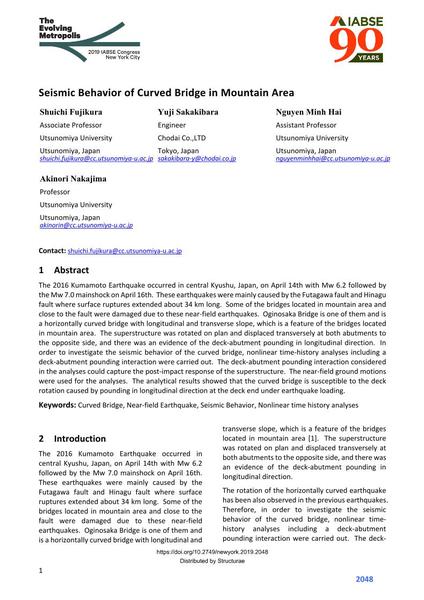Seismic Behavior of Curved Bridge in Mountain Area

|
|
|||||||||||
Détails bibliographiques
| Auteur(s): |
Shuichi Fujikura
(Utsunomiya University)
Yuji Sakakibara (Chodai Co.,LTD) Minh Hai Nguyen (Utsunomiya University) Akinori Nakajima (Utsunomiya University) |
||||
|---|---|---|---|---|---|
| Médium: | papier de conférence | ||||
| Langue(s): | anglais | ||||
| Conférence: | IABSE Congress: The Evolving Metropolis, New York, NY, USA, 4-6 September 2019 | ||||
| Publié dans: | The Evolving Metropolis | ||||
|
|||||
| Page(s): | 2048-2054 | ||||
| Nombre total de pages (du PDF): | 7 | ||||
| DOI: | 10.2749/newyork.2019.2048 | ||||
| Abstrait: |
The 2016 Kumamoto Earthquake occurred in central Kyushu, Japan, on April 14th with Mw 6.2 followed by the Mw 7.0 mainshock on April 16th. These earthquakes were mainly caused by the Futagawa fault and Hinagu fault where surface ruptures extended about 34 km long. Some of the bridges located in mountain area and close to the fault were damaged due to these near‐field earthquakes. Oginosaka Bridge is one of them and is a horizontally curved bridge with longitudinal and transverse slope, which is a feature of the bridges located in mountain area. The superstructure was rotated on plan and displaced transversely at both abutments to the opposite side, and there was an evidence of the deck‐abutment pounding in longitudinal direction. In order to investigate the seismic behavior of the curved bridge, nonlinear time‐history analyses including a deck‐abutment pounding interaction were carried out. The deck‐abutment pounding interaction considered in the analyses could capture the post‐impact response of the superstructure. The near‐field ground motions were used for the analyses. The analytical results showed that the curved bridge is susceptible to the deck rotation caused by pounding in longitudinal direction at the deck end under earthquake loading. |
||||
